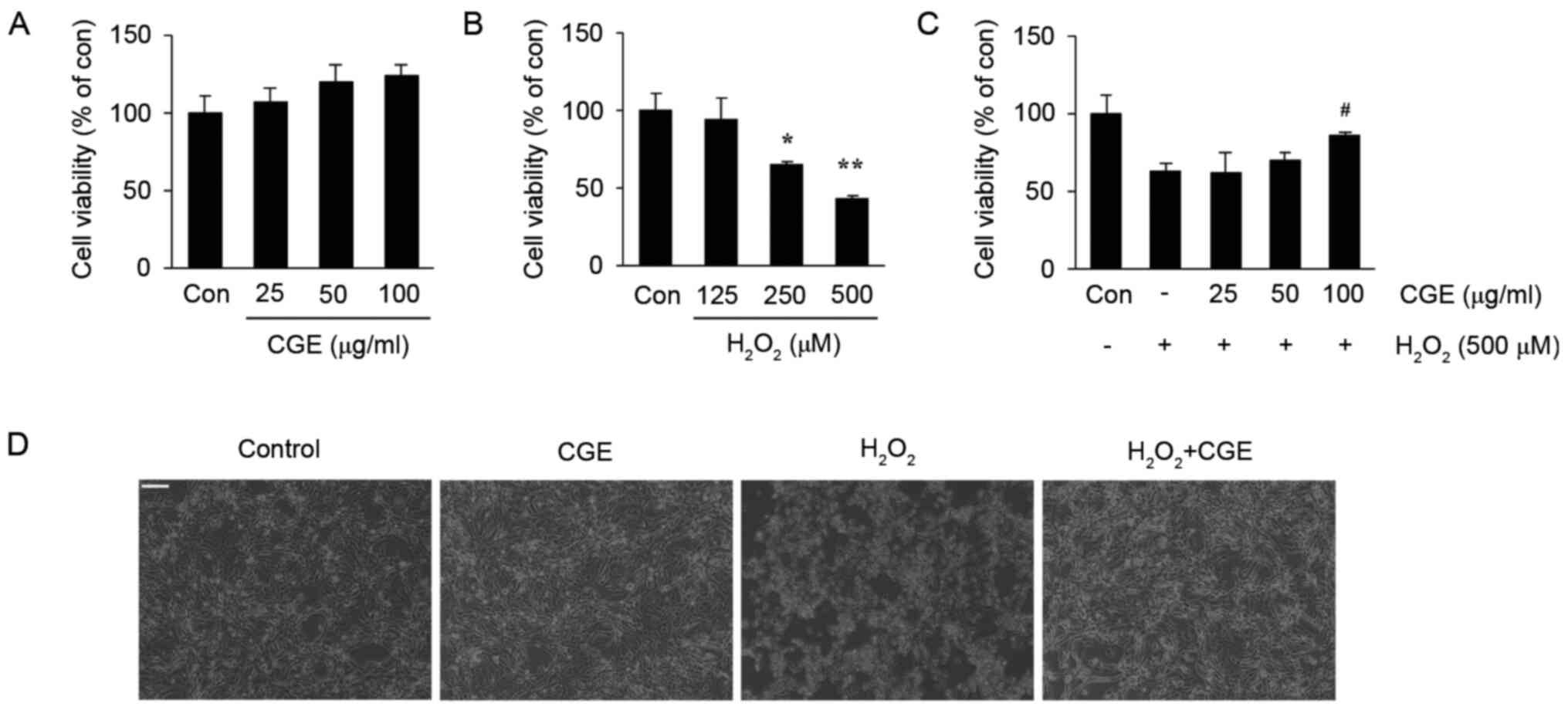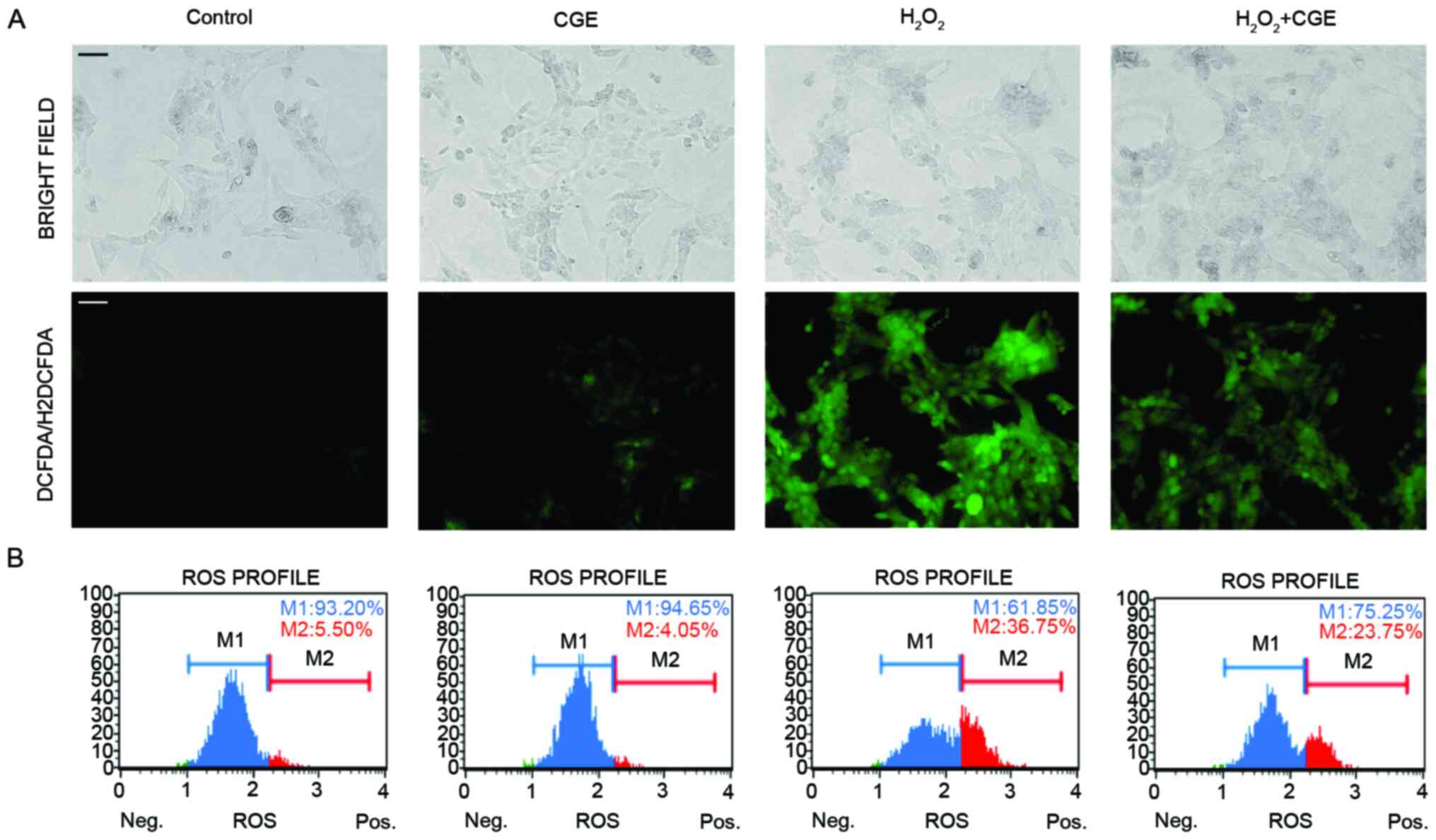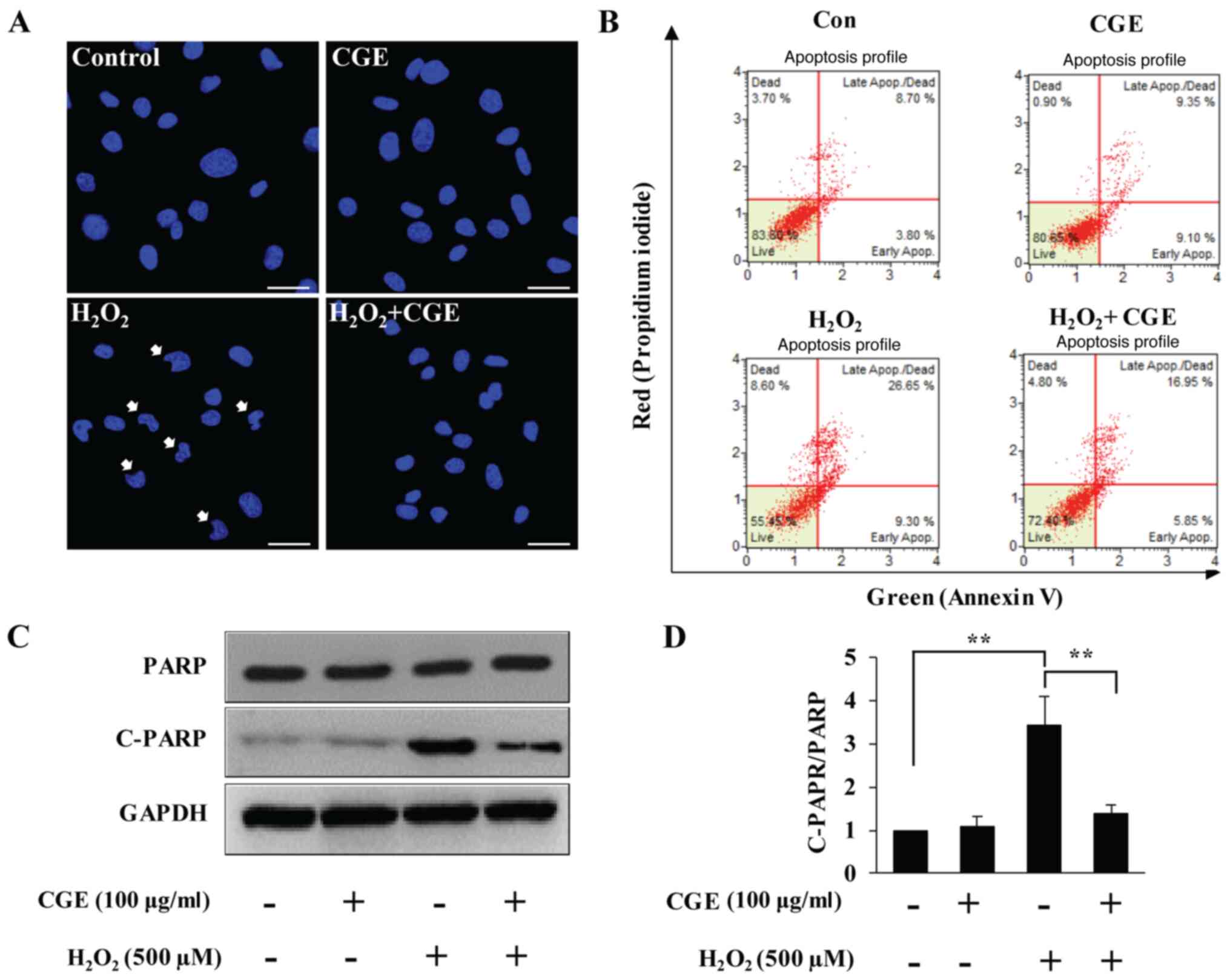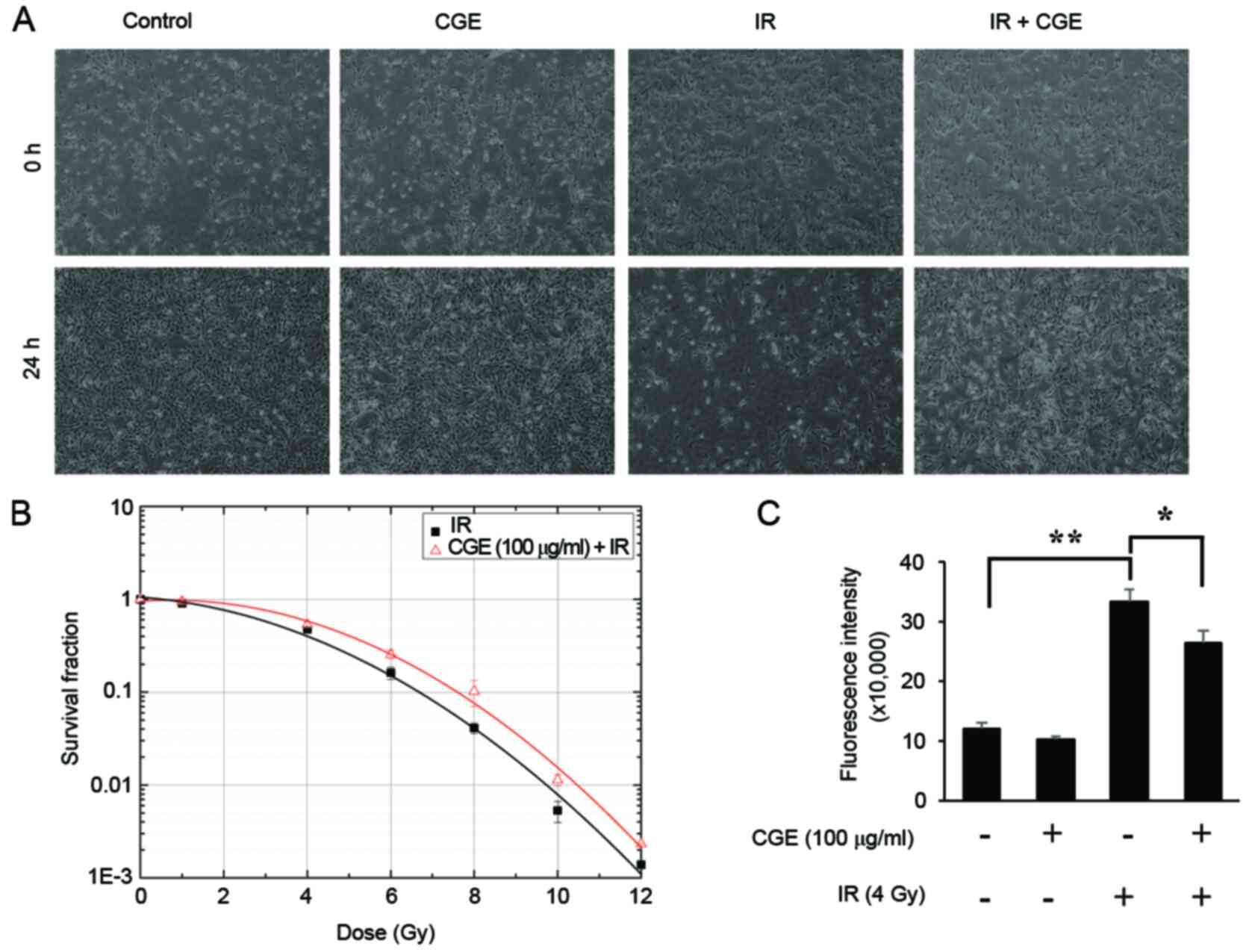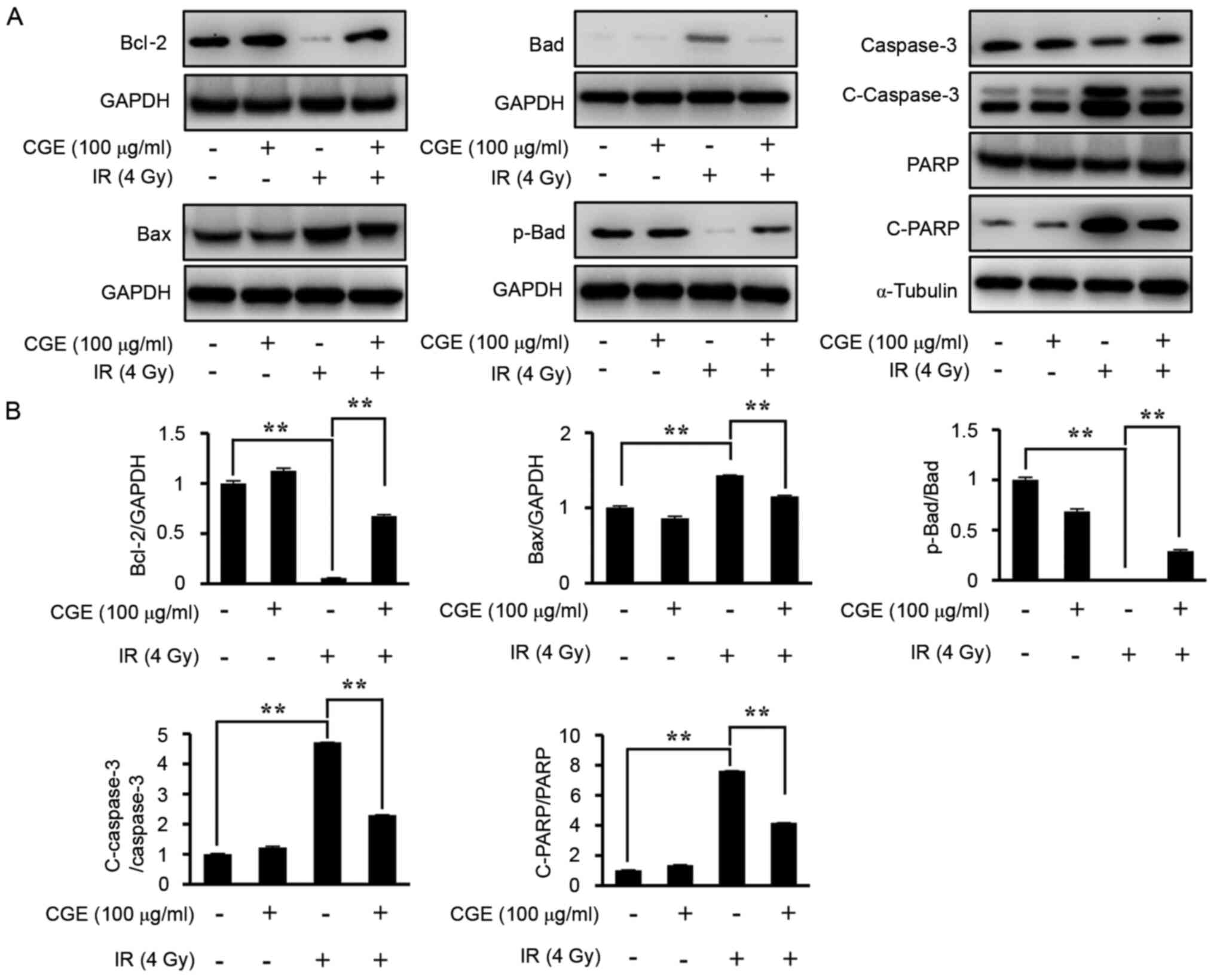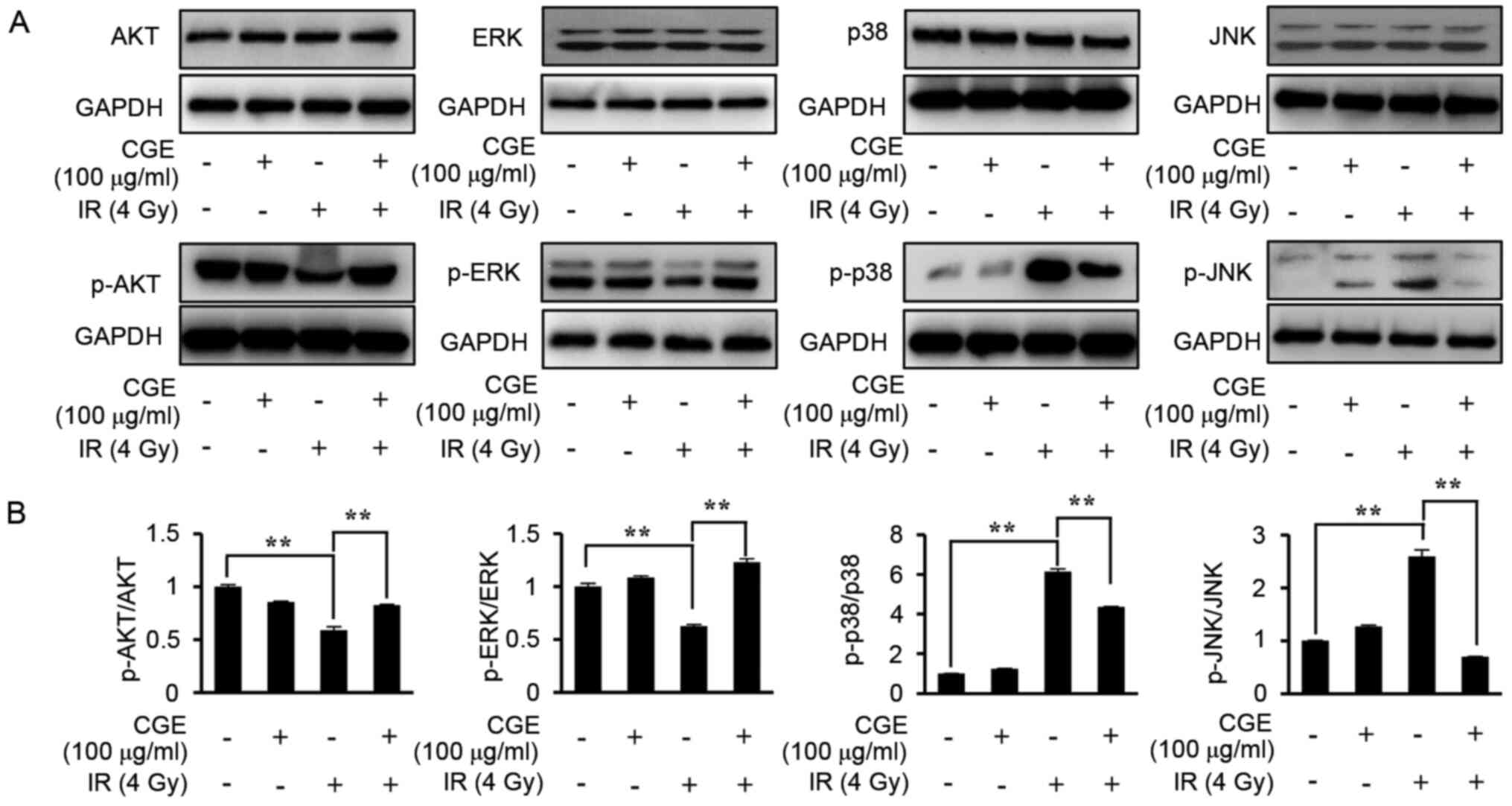|
1
|
Hirata M, Nagakura Y, Yuki N, Adachi K,
Fujii R, Koyakumaru T, Ogura S, Moritake H, Watanabe C and Fukuyama
K: Development and establishment of centipede grass (Eremochloa
ophiuroides) in south-western Japan. Trop Grassl. 41:100–112.
2007.
|
|
2
|
Park HJ, Chung BY, Lee MK, Song Y, Lee SS,
Chu GM, Kang SN, Song YM, Kim GS and Cho JH: Centipede grass exerts
anti-adipogenic activity through inhibition of C/EBPβ, C/EBPα, and
PPARγ expression and the AKT signaling pathway in 3T3-L1
adipocytes. BMC Complement Altern Med. 12(230)2012.PubMed/NCBI View Article : Google Scholar
|
|
3
|
Lee EM, Bai HW, Lee SS, Hong SH, Cho JY,
Lee IC and Chung BY: Stress-induced increase in the amounts of
maysin and maysin derivatives in world premium natural compounds
from centipedegrass. Radiat Phys Chem. 81:1055–1058. 2012.
|
|
4
|
Lee EM, Lee SS, Bai H-W, Cho J-Y, Kim TH
and Chung BY: Effect of gamma irradiation on the pigments and the
biological activities of methanolic extracts from leaves of
centipedegrass (Eremochloa ophiuroides Munro). Radiat Phys
Chem. 91:108–113. 2013.
|
|
5
|
Liu J, Wang C, Wang Z, Zhang C, Lu S and
Liu J: The antioxidant and free-radical scavenging activities of
extract and fractions from corn silk (Zea mays L.) and
related flavone glycosides. Food Chem. 126:261–269. 2011.
|
|
6
|
Choi DJ, Kim SL, Choi JW and Park YI:
Neuroprotective effects of corn silk maysin via inhibition of
H2O2-induced apoptotic cell death in SK-N-MC
cells. Life Sci. 109:57–64. 2014.PubMed/NCBI View Article : Google Scholar
|
|
7
|
Baskar R, Lee KA, Yeo R and Yeoh KW:
Cancer and radiation therapy: Current advances and future
directions. Int J Med Sci. 9:193–199. 2012.PubMed/NCBI View Article : Google Scholar
|
|
8
|
Johung K, Saif MW and Chang BW: Treatment
of locally advanced pancreatic cancer: the role of radiation
therapy. Int J Radiat Oncol Biol Phys. 82:508–518. 2012.PubMed/NCBI View Article : Google Scholar
|
|
9
|
Riley PA: Free radicals in biology:
Oxidative stress and the effects of ionizing radiation. Int J
Radiat Biol. 65:27–33. 1994.PubMed/NCBI View Article : Google Scholar
|
|
10
|
Uttara B, Singh AV, Zamboni P and Mahajan
RT: Oxidative stress and neurodegenerative diseases: A review of
upstream and downstream antioxidant therapeutic options. Curr
Neuropharmacol. 7:65–74. 2009.PubMed/NCBI View Article : Google Scholar
|
|
11
|
Chan RJ, Webster J, Chung B, Marquart L,
Ahmed M and Garantziotis S: Prevention and treatment of acute
radiation-induced skin reactions: A systematic review and
meta-analysis of randomized controlled trials. BMC Cancer.
14(53)2014.PubMed/NCBI View Article : Google Scholar
|
|
12
|
Bolderston A, Cashell A, McQuestion M,
Cardoso M, Summers C and Harris R: A canadian survey of the
management of radiation-induced skin reactions. J Med Imaging
Radiat Sci. 49:164–172. 2018.PubMed/NCBI View Article : Google Scholar
|
|
13
|
Wei J, Meng L, Hou X, Qu C, Wang B, Xin Y
and Jiang X: Radiation-induced skin reactions: Mechanism and
treatment. Cancer Manag Res. 11:167–177. 2018.PubMed/NCBI View Article : Google Scholar
|
|
14
|
Chen J, Zhu Y, Zhang W, Peng X, Zhou J, Li
F, Han B, Liu X, Ou Y and Yu X: Delphinidin induced protective
autophagy via mTOR pathway suppression and AMPK pathway activation
in HER-2 positive breast cancer cells. BMC Cancer.
18(342)2018.PubMed/NCBI View Article : Google Scholar
|
|
15
|
Zhang S and Duan E: Fighting against Skin
Aging: The Way from Bench to Bedside. Cell Transplant. 27:729–738.
2018.PubMed/NCBI View Article : Google Scholar
|
|
16
|
Panich U, Sittithumcharee G, Rathviboon N
and Jirawatnotai S: Ultraviolet radiation-induced skin aging: The
role of DNA damage and oxidative stress in epidermal stem cell
damage mediated skin aging. Stem Cells Int. 2016:7370642.
2016.PubMed/NCBI View Article : Google Scholar
|
|
17
|
Kim JH, Jenrow KA and Brown SL: Mechanisms
of radiation-induced normal tissue toxicity and implications for
future clinical trials. Radiat Oncol J. 32:103–115. 2014.PubMed/NCBI View Article : Google Scholar
|
|
18
|
Smith TA, Kirkpatrick DR, Smith S, Smith
TK, Pearson T, Kailasam A, Herrmann KZ, Schubert J and Agrawal DK:
Radioprotective agents to prevent cellular damage due to ionizing
radiation. J Transl Med. 15:232. 2017.PubMed/NCBI View Article : Google Scholar
|
|
19
|
Painuli S and Kumar N: Prospects in the
development of natural radioprotective therapeutics with
anti-cancer properties from the plants of Uttarakhand region of
India. J Ayurveda Integr Med. 7:62–68. 2016.PubMed/NCBI View Article : Google Scholar
|
|
20
|
Mun GI, Kim S, Choi E, Kim CS and Lee YS:
Pharmacology of natural radioprotectors. Arch Pharm Res.
41:1033–1050. 2018.PubMed/NCBI View Article : Google Scholar
|
|
21
|
Badaboina S, Bai HW, Park CH, Jang DM,
Choi BY and Chung BY: Molecular mechanism of apoptosis induction in
skin cancer cells by the centipedegrass extract. BMC Complement
Altern Med. 13(350)2013.PubMed/NCBI View Article : Google Scholar
|
|
22
|
Bindokas VP, Jordán J, Lee CC and Miller
RJ: Superoxide production in rat hippocampal neurons: Selective
imaging with hydroethidine. J Neurosci. 16:1324–1336.
1996.PubMed/NCBI View Article : Google Scholar
|
|
23
|
Green DR and Kroemer G: The
pathophysiology of mitochondrial cell death. Science. 305:626–629.
2004.PubMed/NCBI View Article : Google Scholar
|
|
24
|
Hata AN, Engelman JA and Faber AC: The
BCL2 family: Key mediators of the apoptotic response to targeted
anticancer therapeutics. Cancer Discov. 5:475–487. 2015.PubMed/NCBI View Article : Google Scholar
|
|
25
|
Dent P, Yacoub A, Fisher PB, Hagan MP and
Grant S: MAPK pathways in radiation responses. Oncogene.
22:5885–5896. 2003.PubMed/NCBI View Article : Google Scholar
|
|
26
|
Di Meo S, Reed TT, Venditti P and Victor
VM: Role of ROS and RNS sources in physiological and pathological
conditions. Oxid Med Cell Longev. 2016:1245049. 2016.PubMed/NCBI View Article : Google Scholar
|
|
27
|
Schieber M and Chandel NS: ROS function in
redox signaling and oxidative stress. Curr Biol. 24:R453–R462.
2014.PubMed/NCBI View Article : Google Scholar
|
|
28
|
Lee AY, Choi JM, Lee MH, Lee J, Lee S and
Cho EJ: Protective effects of perilla oil and alpha linolenic acid
on SH-SY5Y neuronal cell death induced by hydrogen peroxide. Nutr
Res Pract. 12:93–100. 2018.PubMed/NCBI View Article : Google Scholar
|
|
29
|
Azzam EI, Jay-Gerin JP and Pain D:
Ionizing radiation-induced metabolic oxidative stress and prolonged
cell injury. Cancer Lett. 327:48–60. 2012.PubMed/NCBI View Article : Google Scholar
|
|
30
|
Canadian Nuclear Safety Commission (CNSC):
Types and Sources of Radiation. Ottawa, ON, 2014.
|
|
31
|
Bray FN, Simmons BJ, Wolfson AH and Nouri
K: Acute and chronic cutaneous reactions to ionizing radiation
therapy. Dermatol Ther (Heidelb). 6:185–206. 2016.PubMed/NCBI View Article : Google Scholar
|
|
32
|
Leventhal J and Young MR: Radiation
dermatitis: Recognition, prevention, and management. Oncology
(Williston Park). 31:885–887, 894-899. 2017.PubMed/NCBI
|
|
33
|
Reisz JA, Bansal N, Qian J, Zhao W and
Furdui CM: Effects of ionizing radiation on biological molecules -
mechanisms of damage and emerging methods of detection. Antioxid
Redox Signal. 21:260–292. 2014.PubMed/NCBI View Article : Google Scholar
|
|
34
|
Mladenov E, Li F, Zhang L, Klammer H and
Iliakis G: Intercellular communication of DNA damage and oxidative
status underpin bystander effects. Int J Radiat Biol. 94:719–726.
2018.PubMed/NCBI View Article : Google Scholar
|
|
35
|
Redza-Dutordoir M and Averill-Bates DA:
Activation of apoptosis signalling pathways by reactive oxygen
species. Biochim Biophys Acta. 1863:2977–2992. 2016.PubMed/NCBI View Article : Google Scholar
|
|
36
|
Whitaker AM, Schaich MA, Smith MR, Flynn
TS and Freudenthal BD: Base excision repair of oxidative DNA
damage: From mechanism to disease. Front Biosci. 22:1493–1522.
2017.PubMed/NCBI View
Article : Google Scholar
|
|
37
|
Rodríguez-Vargas JM, Ruiz-Magaña MJ,
Ruiz-Ruiz C, Majuelos-Melguizo J, Peralta-Leal A, Rodríguez MI,
Muñoz-Gámez JA, de Almodóvar MR, Siles E, Rivas AL, et al:
ROS-induced DNA damage and PARP-1 are required for optimal
induction of starvation-induced autophagy. Cell Res. 22:1181–1198.
2012.PubMed/NCBI View Article : Google Scholar
|
|
38
|
Ko HL and Ren EC: Functional Aspects of
PARP1 in DNA Repair and Transcription. Biomolecules. 2:524–548.
2012.PubMed/NCBI View Article : Google Scholar
|
|
39
|
Soldani C, Lazzè MC, Bottone MG, Tognon G,
Biggiogera M, Pellicciari CE and Scovassi AI: Poly(ADP-ribose)
polymerase cleavage during apoptosis: When and where? Exp Cell Res.
269:193–201. 2001.PubMed/NCBI View Article : Google Scholar
|
|
40
|
Valerie K, Yacoub A, Hagan MP, Curiel DT,
Fisher PB, Grant S and Dent P: Radiation-induced cell signaling:
Inside-out and outside-in. Mol Cancer Ther. 6:789–801.
2007.PubMed/NCBI View Article : Google Scholar
|
|
41
|
Davis RJ: Signal transduction by the JNK
group of MAP kinases. In: Inflammatory Processes. Springer,
pp13-21, 2000.
|
|
42
|
Chang L and Karin M: Mammalian MAP kinase
signalling cascades. Nature. 410:37–40. 2001.PubMed/NCBI View Article : Google Scholar
|
|
43
|
Fan M and Chambers TC: Role of
mitogen-activated protein kinases in the response of tumor cells to
chemotherapy. Drug Resist Updat. 4:253–267. 2001.PubMed/NCBI View Article : Google Scholar
|
|
44
|
Santabárbara-Ruiz P, López-Santillán M,
Martínez-Rodríguez I, Binagui-Casas A, Pérez L, Milán M, Corominas
M and Serras F: ROS-induced JNK and p38 signaling is required for
unpaired cytokine activation during Drosophila regeneration. PLoS
Genet. 11:e1005595. 2015.PubMed/NCBI View Article : Google Scholar
|
|
45
|
Choi EK, Yeo JS, Park CY, Na H, Lim J, Lee
JE, Hong SW, Park SS, Lim DG and Kwak KH: Inhibition of reactive
oxygen species downregulates the MAPK pathway in rat spinal cord
after limb ischemia reperfusion injury. Int J Surg. 22:74–78.
2015.PubMed/NCBI View Article : Google Scholar
|















